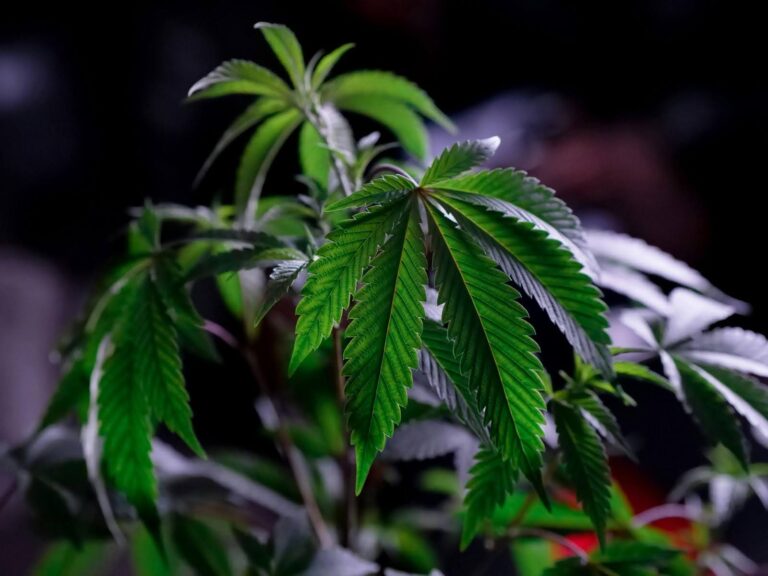Are you optimizing your cannabis development in the vegetative phase? Cannabis cultivation success relies on understanding every phase of its lifecycle. Cannabis growth has four main stages: germination, seedling, vegetative, and flowering.
The vegetative phase lasts the longest, typically 3 to 16 weeks, depending on the strain and growing conditions. This is the most crucial period for establishing strong roots, healthy foliage, and overall plant structure, setting the foundation for a successful harvest.
If you don’t optimize this stage, your plants will struggle to reach their full potential during the flowering phase. By fine-tuning the proper conditions, nutrients, and care, you can position yourself for a bountiful harvest.
This article will take you through the key elements of the vegetative stage. You will discover ideal environmental conditions, successful growth management methods, proper watering and nutrient strategies, and how to identify the ideal time to switch to the flowering phase.
Understanding the Cannabis Vegetative Stage
The vegetative stage is where your cannabis plants establish their foundation. This phase focuses on root expansion, structural development, and canopy formation. Healthy root growth ensures that your plants absorb nutrients effectively, while a robust structure helps them support the weight of future buds. A well-managed canopy maximizes light exposure, leading to even and efficient growth.
What Changes Occur During This Phase?
During this stage, the plant directs its energy into producing strong stems and broad leaves rather than flowering. Key changes include:
- Increased Leaf Growth: The number of leaves expands, allowing for better light absorption and photosynthesis.
- Node Development: Nodes begin to form, determining future bud sites and overall plant structure.
- Stronger Stem Growth: Stems become thicker and more resilient, allowing the plant to support heavier bud formations later.
- Canopy Expansion: The plant spreads out, improving light penetration and energy distribution.
- Root Strengthening: Roots grow deeper and more complex, increasing nutrient uptake efficiency.
- Increased Photosynthesis: More leaf surface area boosts energy production, accelerating plant growth.
- Hormonal Activity: Growth hormones such as auxins and gibberellins become more active, influencing vertical and lateral growth.
A dense canopy maximizes light absorption, boosting photosynthesis and plant health. It regulates temperature, reduces stress, and promotes even bud development for higher yields.
So, how do you create an ideal grow room for your cannabis plant? Let us understand.
Optimal Cannabis Grow Room Conditions
Creating the right environment in your growing space directly impacts plant health. It influences everything from growth speed to disease resistance, making it one of the most crucial aspects of a successful cannabis grow. Several factors must be carefully controlled to ensure optimal vegetative growth:
- Temperature & Humidity: Maintaining stable conditions prevents plant stress. Keep temperatures between 22°C and 28°C, with humidity levels ranging from 40 to 60 percent. Lower humidity levels can slow growth, while excessive humidity may lead to mold and mildew.
Tip: Consider using humidifiers or dehumidifiers to maintain the ideal range, especially in climates with fluctuating humidity.
- Lighting: Cannabis thrives under extended light periods, typically 18 to 24 hours of light per day. The choice of lights matters—LED and MH (Metal Halide) lights provide the best spectrum for vegetative development.
- Airflow & Ventilation: Proper ventilation ensures that plants receive fresh air and prevents stagnant, humid conditions that can lead to disease. Oscillating fans help distribute air evenly, strengthening stems and improving plant resilience.
- CO₂ Enrichment: Increasing CO₂ levels in the grow room can significantly boost photosynthesis and plant vigor. This is particularly beneficial in sealed growing environments where airflow is more controlled.
- Grow Medium Considerations: The growing medium (soil, coco coir, hydroponics) also affects environmental conditions. Soil requires proper aeration and drainage, while hydroponic systems need precise nutrient and pH adjustments to maintain optimal growth conditions.
- Climate Control Systems: Advanced growers may use air conditioning units, heating systems, or automated controllers to maintain a stable climate inside the grow room.
Now, let us understand the techniques that help in managing cannabis growth properly.
Techniques for Managing Cannabis Growth
Uncontrolled growth can lead to overcrowding, poor airflow, and uneven canopy development. Strategic growth management techniques keep your plants healthy, maximize light exposure, and promote better overall yields. Let us look at some of the methods to manage cannabis growth properly:
- Topping: Cutting off the top of the main stem encourages bushier growth by promoting lateral branching. This method helps increase the number of bud sites, ultimately leading to higher yields.2.
- Pruning: Removing lower branches and excess foliage that do not receive enough light improves airflow and redirects energy to healthier parts of the plant.3.
- Trimming: Regularly cutting unnecessary leaves prevents overcrowding and ensures that all parts of the plant receive adequate light.4.
- Low-stress training (LST): Gently bending branches without breaking them helps create an even canopy. This method ensures better light penetration, leading to uniform growth and improved bud development.5.
- High-stress training (HST): Techniques such as super cropping involve slightly damaging stems to encourage thicker growth and greater stress resilience.6.
- Screen of Green (ScrOG): Training plants horizontally with a screen maximizes light exposure and increases canopy efficiency.7.
- Defoliation: Removing select fan leaves strategically allows better airflow and ensures energy is directed toward bud production.
So, how do you ensure proper feeding of your cannabis during the vegetative stage? Here’s how to do it.
Feeding Cannabis During the Vegetative Stage
Nutrients fuel growth, and during the vegetative stage, cannabis requires a higher concentration of nitrogen. This essential nutrient supports leafy growth and strong stems. The ideal NPK (Nitrogen-Phosphorus-Potassium) ratio for this stage is around 3:1:1, ensuring the plant gets what it needs to thrive.
To further enhance plant health and vigor, consider the following:
- Micronutrients: Cannabis also benefits from iron, manganese, zinc, and copper, which play crucial roles in photosynthesis and enzymatic reactions.
- Calcium & Magnesium: These nutrients strengthen cell walls, improve nutrient uptake, and help prevent deficiencies like leaf curling and spotting.
- Organic vs. Synthetic Fertilizers: Organic fertilizers release nutrients slowly, improving soil health, while synthetic fertilizers provide immediate availability for rapid plant response.
- Feeding Frequency: It’s crucial to feed your plants regularly but not excessively. Overfeeding can lead to nutrient lockout, where excess nutrients hinder absorption.
- Soil vs Hydroponic Feeding: Soil-grown cannabis benefits from organic amendments like compost and worm castings, whereas hydroponic setups require precise nutrient formulations to prevent imbalances.
- Amino Acids and Beneficial Bacteria: Adding amino acids and beneficial bacteria can boost plant metabolism, improve root function, and enhance nutrient uptake.
- pH Monitoring: Ensuring the nutrient solution has the correct pH (between 6.0 and 6.5 for soil and 5.5 to 6.0 for hydroponics) helps prevent nutrient deficiencies and absorption issues. PlanaCan eliminates the guesswork by capturing precise data on every harvest, helping you link key decisions to real outcomes. Moreover, by consolidating all insights in one place, PlanaCan streamlines cultivation methods for higher yields and bigger profits.
- Silica Supplementation: Adding silica strengthens cell walls, making plants more resistant to environmental stress and pests.
- Slow vs. Fast-Release Nutrients: Balancing slow and fast-release nutrients can help sustain growth without sudden deficiencies.
Next, let us discuss how to water your cannabis properly during the vegetative phase.
Watering During the Vegetative Phase
Watering practices can make or break your cannabis plants. Overwatering can suffocate roots, leading to rot and nutrient deficiencies, while underwatering slows growth and weakens the plant. Striking the right balance is crucial to maintaining a healthy root system and promoting vigorous growth.
- Watering Frequency: Water should be applied when the top inch of the soil feels dry. Overwatering can lead to fungal infections and root rot, whereas underwatering may cause stunted growth and issues with nutrient uptake.
- Water Quality: Using clean, pH-balanced water prevents nutrient lockout. Filtered or dechlorinated water is preferable, as excess chlorine can harm beneficial microorganisms in the soil.
- Drainage Considerations: Proper drainage is essential to prevent excess moisture from accumulating in the growing medium. Ensure your containers have adequate drainage holes, and consider adding perlite or coco coir to improve aeration.
- Hydroponic Watering: Maintaining oxygenated water and monitoring electrical conductivity (EC) levels ensures optimal nutrient absorption in hydroponic setups. Regular water changes also help prevent salt buildup.
- Moisture Monitoring: Using tools like moisture meters or observing plant leaves for signs of over- or underwatering (such as drooping or curling) can help you fine-tune your watering schedule.
- Temperature Considerations: Warmer temperatures may require more frequent watering, while cooler temperatures reduce the plant’s need for hydration.
Monitoring soil or hydroponic moisture levels helps you adjust watering without overdoing it. PlanaCan eliminates guesswork by helping to monitor watering schedules and to ensure precise adjustments. Moreover, it tracks harvest data, linking decisions to real impact. By consolidating insights, you refine methods for higher yields and bigger profits.
Timing the Transition to the Flowering Stage
Knowing when to transition from vegetative to flowering is key to maximizing yields. The shift occurs when plants receive 12 hours of uninterrupted darkness, triggering hormonal changes that lead to bud development. This transition is crucial, as it marks the beginning of a new growth phase requiring different care and nutrient adjustments. Here are the key factors to consider before transitioning:
- Plant Maturity: Before entering the flowering stage, plants should have a strong root system, sturdy structure, and ample leaf coverage. Premature transitions may result in smaller yields and weaker plants.
- Height and Space Management: Since plants stretch significantly during flowering, consider your growth space limitations. Transitioning at the right time helps prevent overcrowding and maintains optimal airflow.
- Training Completion: If you’ve applied techniques like low-stress training (LST), topping, or pruning, ensure plants fully recover before inducing flowering.
- Health Check: Before transitioning, address any nutrient deficiencies, pests, or diseases. Weak plants will struggle to produce dense, high-quality buds. PlanaCan simplifies soil monitoring, taking the guesswork out of plant care. Moreover, it tracks harvest data, linking key decisions to real results. PlanaCan helps refine your methods for higher yields and bigger profits by centralizing all insights.
- Genetics and Strain Considerations: Some strains have different vegetative stage requirements; indica tend to stay shorter, while sativas may require more vegetative time to reach full potential.
- Root System Development: A well-developed root system ensures better nutrient and water absorption during flowering, leading to higher yields.
- Environmental Readiness: Ensure temperature, humidity, and airflow conditions are optimized for the upcoming flowering stage to reduce the risk of stress or deficiencies.
Conclusion
Mastering the vegetative stage is a critical step in cultivating high-quality cannabis. Every detail matters, from optimizing environmental conditions to managing growth and providing the right nutrients. Fine-tuning your techniques ensures your plants are strong, healthy, and prepared for a successful flowering stage.
If you’re looking to streamline your cultivation process and maximize yields, PlanaCan offers essential tools to simplify cannabis management.
With PlanaCan, you can streamline task scheduling by automating cultivation processes with customizable templates. Each grow cycle, from planting to harvest, can be outlined for specific strains or cycles. Once templates are set, tasks can be scheduled with a few clicks, ensuring consistency.
It also provides a clear timeline for planning ahead while managing daily activities. Ongoing tasks can be adjusted to meet your plant’s needs, preventing missed steps. By centralizing all cultivation information, PlanaCan keeps your team organized and efficient.
Integrating PlanaCan into your workflow can enhance efficiency, reduce errors, and stay ahead in your growing operation. Schedule a free call today to learn how PlanaCan can help you achieve optimal results in your cannabis cultivation journey.




